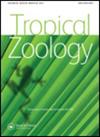在巴西里约热内卢州大西洋森林首次发现埃及伊蚊种群
IF 0.4
4区 生物学
Q4 ZOOLOGY
引用次数: 2
摘要
埃及伊蚊几乎完全局限于人类改造的环境,特别是城市地区,很少入侵森林。诱卵器在巴西里约热内卢州的一个保护区(Bom Retiro)使用。埃及伊蚊的卵与城市蚊子的卵在遗传上无法区分,在森林边界700多米和森林入口处小径900米处获得。埃及伊蚊在原始森林中的存在表明它有能力适应巴西的森林环境,这表明由于难以控制这些蚊子,几种虫媒病毒传播的可能性很大。本文章由计算机程序翻译,如有差异,请以英文原文为准。
The first detection of a population of Aedes aegypti in the Atlantic Forest in the state of Rio de Janeiro, Brazil
Aedes aegypti is almost completely restricted to human-modified environments, especially urban areas, and rarely invades forests. Ovitraps were utilized in a reserve (Bom Retiro) in Rio de Janeiro state. Eggs of A. aegypti, genetically not differentiable from those of urban mosquitoes, were obtained at a location more than 700 m inside the border of the forest and 900 m away from a trail at the entrance to the forest. The presence of A. aegypti in a primary forest indicates its ability to adapt to sylvatic environments in Brazil, suggesting great potential for the transmission of several arboviruses due to the difficulty in controlling these mosquitoes.
求助全文
通过发布文献求助,成功后即可免费获取论文全文。
去求助
来源期刊

Tropical Zoology
生物-动物学
CiteScore
2.50
自引率
0.00%
发文量
1
审稿时长
>12 weeks
期刊介绍:
Tropical Zoology is an international zoological journal publishing original papers in the field of systematics, biogeography, phylogeny, ecology and conservation of all terrestrial and aquatic animal Phyla from tropical and subtropical areas.
Only papers with new information, high quality and broad interest are considered. Single species description and checklists are not normally accepted. Review papers are welcome. The journal is owned by the Istituto di Ricerca sugli Ecosistemi Terrestri of the Consiglio Nazionale delle Ricerche, Florence, Italy (CNR-IRET) who performs research into the structure and functioning of aquatic and terrestrial ecosystems, focusing in particular on anthropogenic pressure and global change. The knowledge amassed forms the scientific basis for identifying the most appropriate protective and corrective interventions, and provides support for the bodies entrusted with formulating policies for environmental protection and recovery.
 求助内容:
求助内容: 应助结果提醒方式:
应助结果提醒方式:


